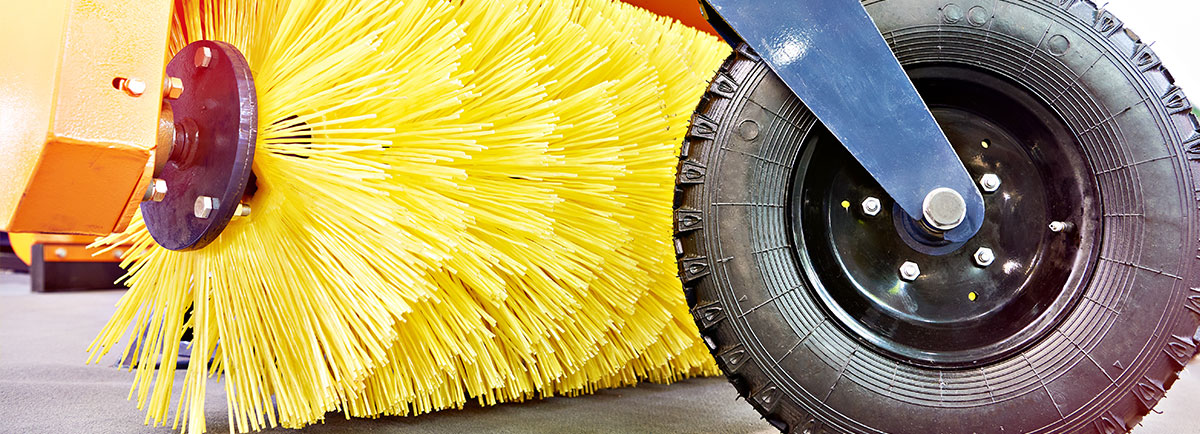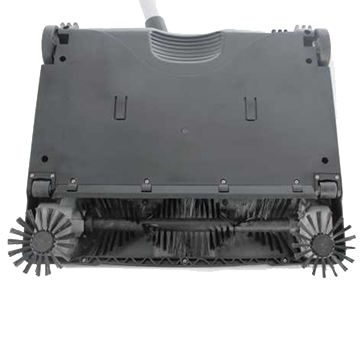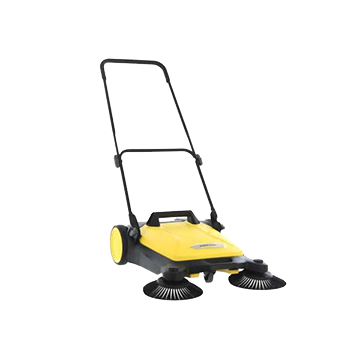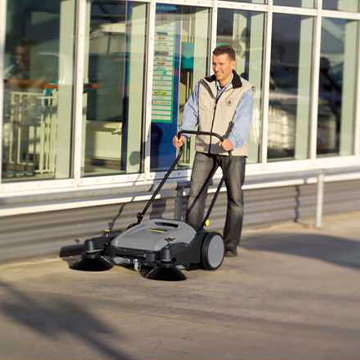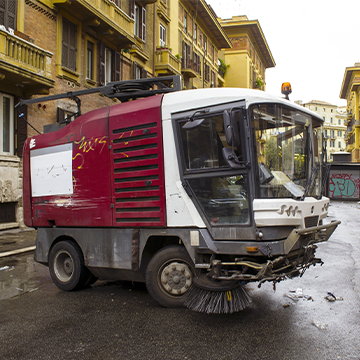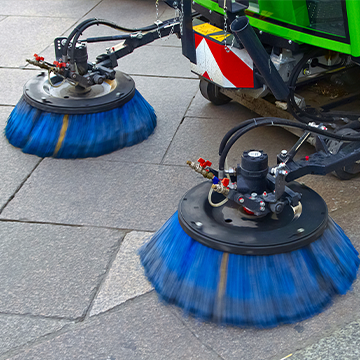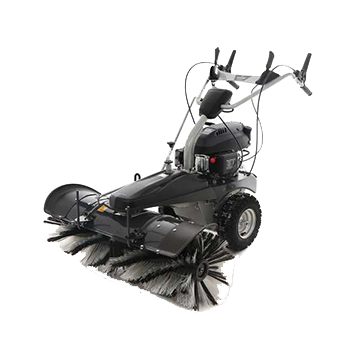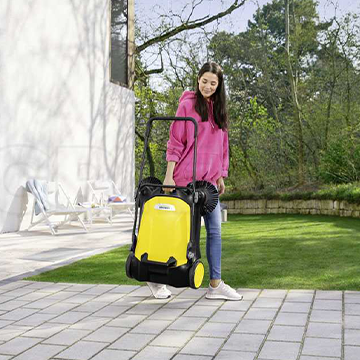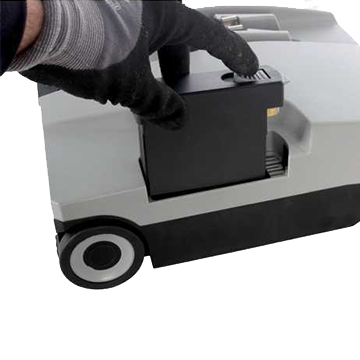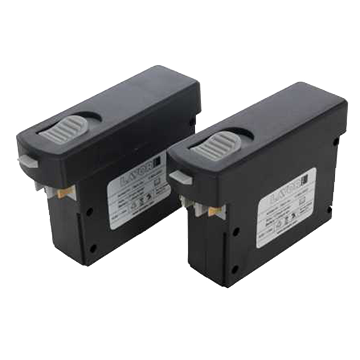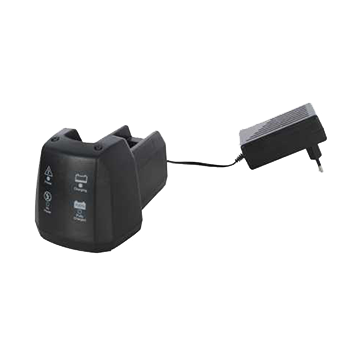A comprehensive guide to purchasing the best power sweeper, with all its main features.
The Complete Guide to help you choose the Best Power Sweeper
by the Real Experts of Machinery for Outdoor Cleaning and Maintenance
When we talk about “sweepers” we are referring to those machines designed to collect solid debris, such as leaves, branches, light layers of sand, earth, in some cases snow and dirt in general, from outdoor areas, such as paths, roads, courtyards, entrances, or indoor areas, like factories, sheds and storerooms, through the mechanical action of brushes.
Sweepers, also known as “power sweepers” or “power brooms“, serve to remove “loose dirt”, i.e. dirt that is not encrusted or in any way adhering to the floor.
This first definition allows us to make a clear distinction with another machine, the floor scrubber dryer, which is very often confused by less-experienced users.
Floor scrubber dryers are not made to remove “loose dirt”, as power sweepers do, but their main function is to perform a deep cleaning and washing of the floor, removing all the dirt that has stuck to it.
The power sweeper is a versatile and manoeuvrable machine can be used indoors and outdoors on many materials such as concrete, asphalt, carpet and all types of short-pile textile floors.
This new purchasing guide will discuss the different types of electric cleaning machines available on the market, their operation and all the information you need to know to choose the best power sweeper for your needs.
CONTENTS
1. How is it made?
Each power sweeper consists mainly of three parts:
- Sweeping unit
This refers to the set of brushes that, thanks to their rotating movement, collect dirt from the floor. There are models with only side brushes, others with a maxi central brush or roller and others with disc and roller. In some models (the larger ones, such as ride-on models), the side brushes convey the dirt towards the centre of the machine where the central cylindrical brush is located, which, by rotating, loads the accumulated dirt into the collector.

Double side brushes
and mini central roller
Detail of the side brush 
Maxi horizontal central brush
- Collection tank (or collector)
This is the part of the machine where dirt and debris is collected and stored during cleaning operations.

Hand push power sweeper
and collector
Medium collector 
Small collector
(Battery-powered model)
- Suction unit
It consists of a fan which, by creating a strong vacuum, draws in the dirt accumulated by the side brushes and loaded by the central brush;
2. Types
There are various types of power sweepers, which differ in some fundamental aspects, such as the position of the operator in relation to the machine. From this first distinction, we can identify two types of sweepers:
- Hand-push power sweepers
- Ride-on power sweepers
The first type, also known as walk-behind sweepers, includes manual sweepers, which can be either “push” or “pull” power sweepers. The second group, namely ride-on power sweepers, includes the models commonly known as “road models”, which are used to clean the streets and pedestrian paths of large cities.
Another aspect that defines the type of machine is the type of power supply, that is:
- Manual push models, which have no engine
- Self-propelled, i.e. powered by a 4-stroke engine, electric motor (230 V) or battery-powered
Finally, a distinction can be made regarding the type of collection system: some models have front or rear collectors, others instead do not have any debris of leaves collection system and only perform the function of sweeping away the dirt.
2.1 Manual push power sweepers
Space-saving and cost-effective, manual push power sweepers are ideal for smaller areas. As mentioned a few lines above, this type of sweepers differ from other models precisely because they do not have a motor to push the machine and operate the brushes; this feature makes them suitable for use mainly in enclosed spaces.
In manual push, or hand-push models, the sweeping system is mechanically connected to the wheels, so the operator, by pushing forward the power sweeper, causes both the machine to move and the brushes or rollers of the sweeping unit to rotate.

Karcher KM 70/20 
Karcher S 4 Twin 
Stiga SWP 475
2.2 Walk behind power sweepers
The term “walk-behind sweepers” refers to those models in which the operator pushes or walks alongside the machine (in the case of self-propelled models) during cleaning work.
This category includes all manual push machines and some self-propelled models, i.e. with a motor that powers the brushes and provides the necessary thrust to operate the machine in its cleaning work, without too much effort for the operator.
2.3 Ride-on power sweepers
In this type of power sweepers the operator is on board the machine and drives via a steering wheel or controls placed on the sweeper.
Ride-on power sweepers are all equipped with a engine powerful enough to allow the machine to move forward, move the brushes and carry the operator.
These models are particularly high-performance machines with powerful engines and are mainly employed in semi-professional, heavy-duty and industrial applications.
2.4 City sweepers
Finally, there are the city sweepers (also know as road sweepers or street sweepers): these are the largest and most powerful models, capable of cleaning particularly wide areas, such as city streets.
In large cities, they are used for routine cleaning of city centres, car parks and other outdoor areas.

City power sweeper 
Brush of a road sweeper
Of course, just like self-propelled power sweepers, street sweepers are equipped with a high-performance engine and have to be driven by operators on board like normal road vehicles.
3. Power supplies
With the exception of manual push sweepers, which are not fitted with an engine or an electric motor, all other models fall into two categories: electric power sweepers and petrol power sweepers.
3.1 Manual push power sweepers
Manual push power sweepers are less performing than models equipped with an engine or an electric motor and have a significantly lower cost. These models have the best value for money on the market and are perfectly suitable for private users’ requirements and the domestic cleaning of small, non-extensive areas.
Because they do not have a motor, manual push models are fairly easy to use:
the operator pushes the machine with his own strength, allowing the machine and its wheels to move forward. The wheels are in turn connected to the brushes, which will be driven by the movement of the machine.
3.2 Electric and battery-powered sweepers
Because they do not have a petrol engine, electric and battery-powered power sweepers are mainly employed for cleaning work in enclosed spaces.

Lavor Pro BSW 375 ET 
Eurosystems Sandy
While electric models have no problem with working autonomy and working hours, in battery-powered models, the quality of the battery, recharging times and, above all, its durability should be taken into account.
3.3 Petrol power sweepers
Petrol powered sweepers are particularly powerful, thanks to their 4-stroke engine, and are considerably more expensive than other types. They are especially recommended for intensive use on very large areas.
As mentioned above for electric or battery-powered models, this type of power sweeper is not suitable for use in enclosed spaces, due to the exhaust gases produced by the petrol engine.

Stiga SWS800G 
Blackstone GS100V-K
When planning the purchase of a petrol power sweeper, it is important to give due consideration to the engine. It is often the case that less-experienced users do not take into account all the fundamental aspects regarding the engine the machine is equipped with. Regardless of the displacement, we recommend to move towards the most renowned brands, so as to be sure to get reliability and high performance.
The main engine brands we recommend include:
4. Main features
Among the elements worth of particular attention when choosing the most suitable power sweeper for your needs is the hourly output, the working width, the working surface and much more.
4.1 Working width
The working width is mainly the space that the machine in operation is able to cover. The larger the working width, the less time it will take for the power sweeper to clean a certain surface.
The working width can range from 20-40 cm in smaller and less performing models, to over 2 metres in city sweepers. In general, all power sweepers with over 75 cm of working width qualify as suitable for semi-professional and heavy-duty use.
For limited cleaning work requirements and small working areas, it is better to move towards smaller models with a standard working width. Owning a small-sized machine will allow the user to work more comfortably and will not take up too much space in the storeroom or garage.
4.2 Hourly output
Another very important aspect is the hourly output, i.e. the ratio between the working width and the working speed of the machine. This formula shows the actual size of the area that the power sweeper will be able to clean in one hour.
Hourly output (m/h) = Working width x Working speed
4.3 Vacuum
For a more efficient sweeper able to perform a more thorough and deep cleaning and is also capable of removing viscous waste, then it is better to rely on specific models, such as vacuum sweepers.
These machines feature a vacuuming function which draws in the waste that is collected and pushed towards the central part by the rotating brushes. As a result, the machine does not just sweep and push the dirt towards the collector, it also directs the dirt towards the centre of the machine, where it is then vacuumed and loaded into the collection tank.
5. Working autonomy
When purchasing a battery-powered electric machine, it is absolutely essential to take into account the battery running time
This aspect is of primary importance as the hourly output of the machine mainly depends on it.

Inserting the battery 
Double battery 
Battery charger
The working autonomy of battery-powered models varies according to the quality of the power supply and the number of batteries connected to the machine; affordable models have a running time of around 45 minutes, while the most professional models can reach up to 10 hours.
6. Brands
Again, before proceeding with the purchase of a power sweeper, it is also important to take into account the manufacturer.
Some of the major brands to keep in mind when choosing the best suited manual push or ride-on power sweeper for your needs include: Stiga, Eurosystems, Lavor, Kärcher, Haaga, Hako, Faip, Eureka, Tennant.



